Celebrating World Spay Day: Getting to the Spay, and Results
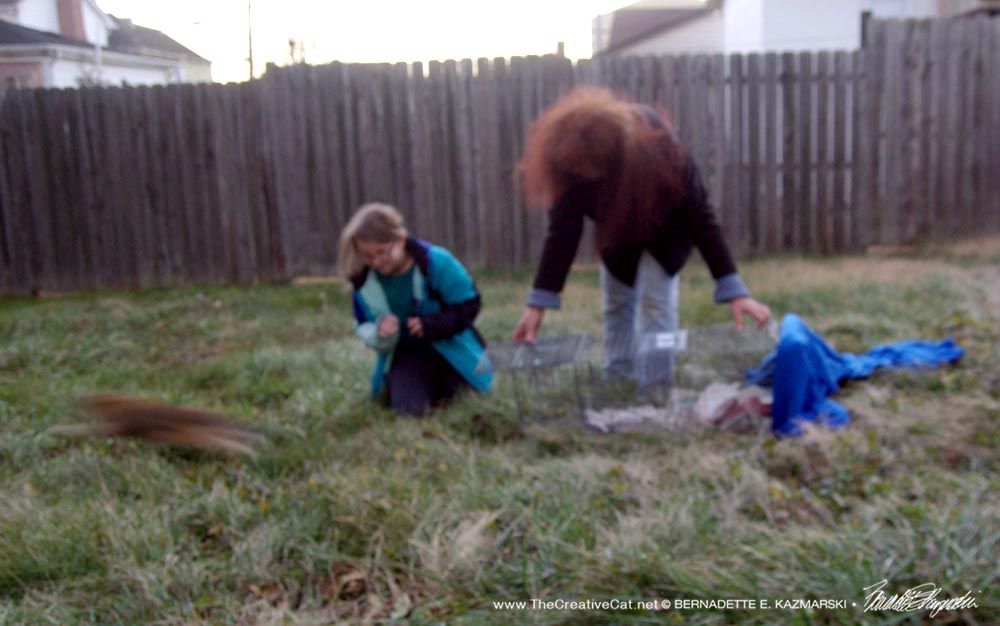
When I moved into my house in October 1990, I found about 20 cats were living in the back yard. I’d been rescuing cats living in the house I’d rented up to that time, and even before that, but this group of cats all at once was daunting. My house had been unoccupied for the better part of the year, and the former owners weren’t really outdoor people anyway, so cats felt free to form a little colony back there. I learned that most of them had been pets and ended up outdoors because landlords didn’t permit pets, or had been left behind when someone moved, or a cat was someone’s mostly outdoor pet. Many people didn’t spay or neuter their pets at that time, and waiting to six months was standard, so then came the kittens, who were feral having grown up outdoors and away from contact with humans.
World Spay Day falls on the last Tuesday in February, this year February 23, just in time to catch the girls as they go into their first heat of the season. “Getting to the spay” is number one, the hurdle of time and expense if a cat needs to be trapped or an owner convinced, but the most satisfying part of the situation, knowing they can never reproduce and, at least from that cat, I wouldn’t be chasing litters of kittens under someone’s porch. When I moved in and found the colony in my yard, some disappeared, and the owned cats had just enough contact with their humans that I learned to help by keeping them in place. But the rest, I worked with the process of bringing them indoors and getting to know them and getting them spayed and neutered, vetted, then finding a new home using prints of photos and my telephone to contact and network.
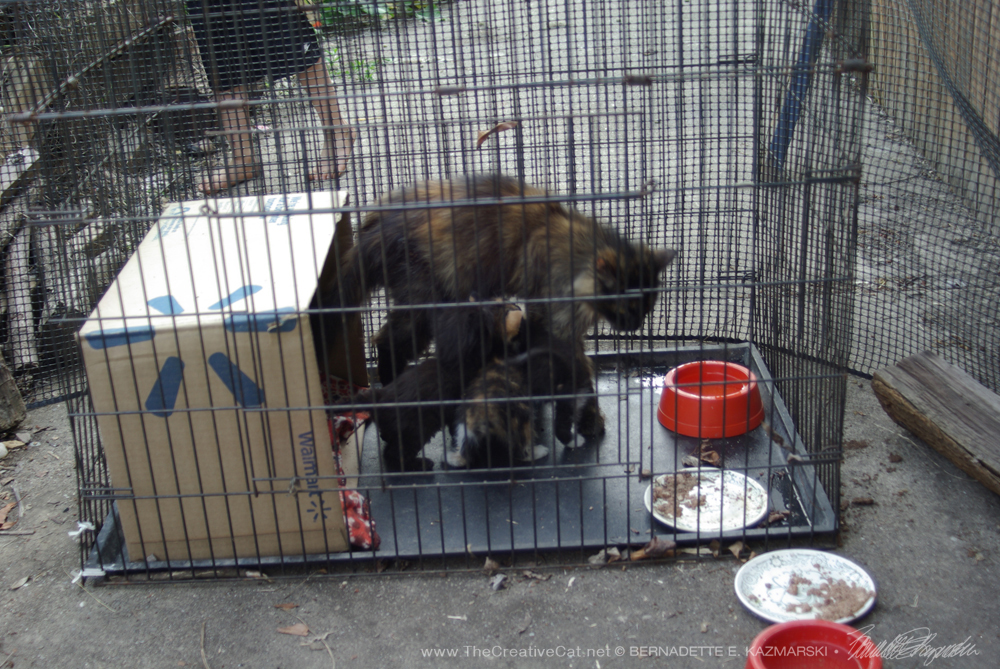
From that beginning, we still have a high rental rate which often results in a higher than usual rate of abandoned pets, but by keeping track of cat populations in the neighborhood we can keep the numbers down and avoid new generations. Getting to know my neighbors, with lots of help from kids in the neighborhood, I kept track of the cats in my neighborhood, pulling abandoned pet cats off the street when possible, vetting, fostering, adopting—or not, as Cookie became a permanent resident in the early 90s, later Lucy, and then Mimi and her “kittens” are still with me. When I lived in the rented house just blocks away from here came Stanley and “my first litter” including Fawn and Nikka. You’ve read about many others here too: all the kittens that came from the house where Mimi had lived, including Lucy’s siblings Charlotte, Angus and Donal; also Murphy, Tess and her boys, Sun-ra, Ysabel, Sasha, Smudge and Timmy, Mr. Mistoffelees, Jack, Sputnik and Thistle, and the story Witness to a Rescue.
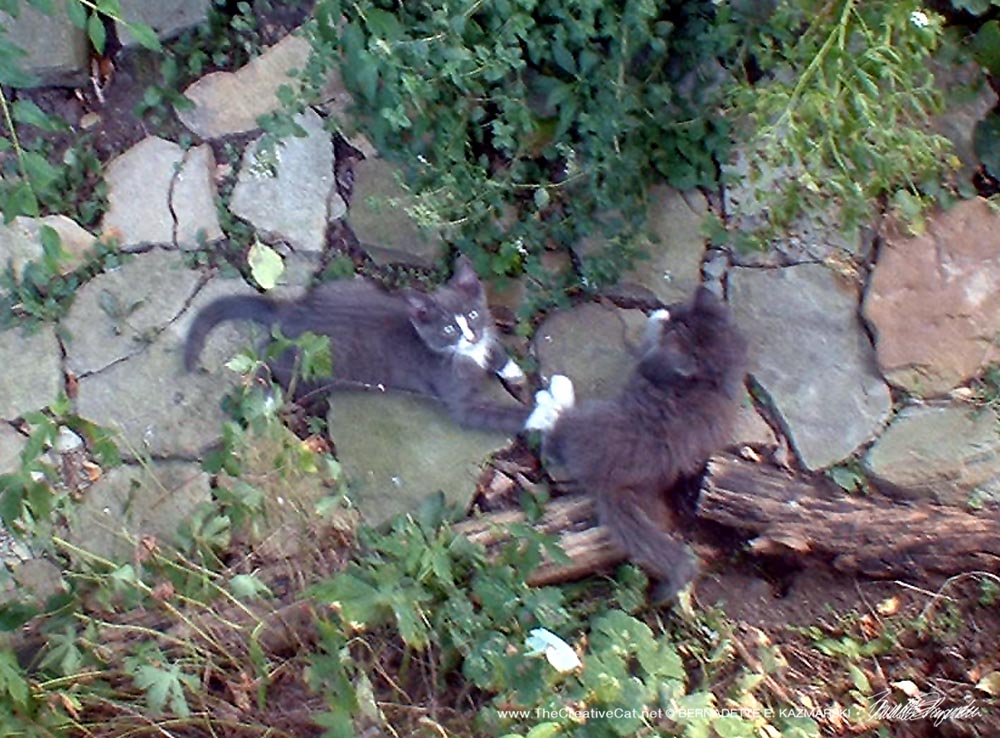
In more recent years I’ve assisted others in rescuing and fostering, like the elusive ginger cat, and Gabby. Once I started volunteering with the Homeless Cat Management Team I could do more than rescue friendly cats, I could provide TNR to community cats like Charm and her kittens and all the cats in her neighborhood, Mariposa’s colony a few blocks away from me here in Carnegie, Sienna and the other cats who lived in her neighborhood, and feral parents and young kittens on the other side of the hill from me. I’ve done that ever since, and watched as resources for rescue increased and getting to that spay ever more possible, and seeing the results of reducing the numbers of new kittens, growing into cats living on the street.
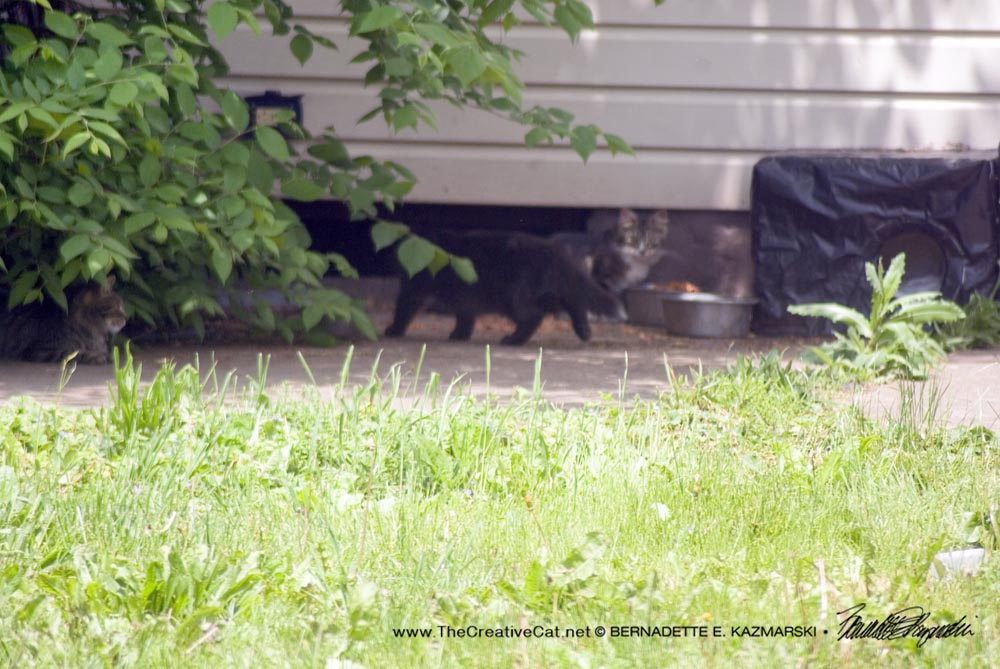
A c0uple of years ago I was chasing cats who needed to be spayed all over the area. It’s always been my joy to help both cats and people solve this problem to everyone’s satisfaction, and from all the trapping for eight kittens and three mothers on Cherrydell to Allie and her kittens on Greenbriar to Smokey in Crafton, and plenty of singles and smalls in between all those, each situation avoided the births of more kittens with spays as well as neuters. With a few of the people I’d assisted with TNR and finding their lost cats donating traps to me, and the resources of HCMT to rely on, I could both trap those cats and advise and teach or mentor people to undertake it on their own.
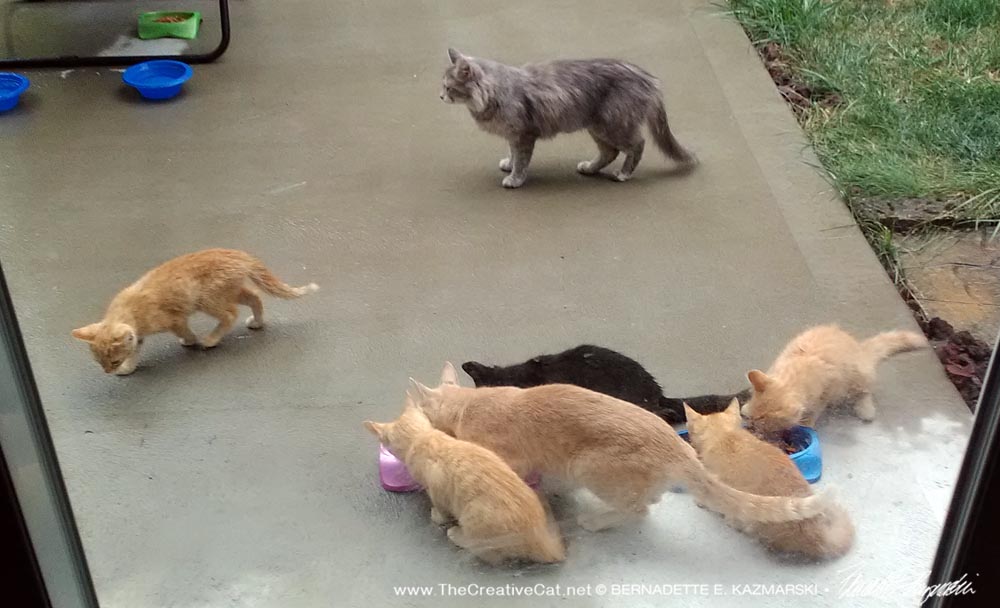
At the same time my hip had deteriorated, but it would be months of limping and dragging my leg before I’d discover I had to have it replaced, and I had to stop with the big projects. But not to worry—I could sit here in my house and help connect and keep in touch with everyone in my own neighborhood, advising handling or trapping, loan traps and resources, scheduling appointments for spays and neuters as we’ve had no shortage of adult strays and feral cats to work with here, like helping Denise with her colony, as well as individuals like Nugget, F’Ave Tux, and Ling.
After all this work, all these spays especially, we only had one litter of kittens last year, from one house where we know they feed and don’t fix, but we have to trap offsite. That is a total win, especially in a year when our usual resources for surrendering to the smaller rescues we’ve worked with aren’t available because their options for offsite adoption have slowed down due to COVID restrictions. But we hope to achieve “no kittens” and keep it that way.
Personally, I’ve been celebrating Spay Day every time a surgery is scheduled. I’m glad for all the unwanted kittens whose births I’ve helped prevent, and didn’t have to eventually rescue or watch suffer and possibly die because of circumstances I can’t control. And helping all the mother cats who will no longer suffer from the constant strain of reproduction on their bodies. Oh, and those boy cats too—even though we’re celebrating “spay” day, they aren’t off the (ovariohysterectomy) hook.
Celebrate Spay Day USA with Mimi and Me
If preventing the birth of potentially 420,000 kittens…okay, 420,000 is a highly inflated figure, but several hundred kittens is typical of an unspayed female and one or more unneutered males and all their progeny, and preventing the birth of that number is just as good. If preventing the birth of realistically several hundred kittens isn’t a good enough reason to have your cat spayed, then I have a few more reasons to give you, and so does Mimi, mother of 24 and a huge advocate of spaying.
The issue of feline overpopulation, and why humans are part of it
Cats left unspayed and unneutered whether in free-ranging colonies or in your own home will produce as many kittens as their bodies will allow, leading to disease and suffering and way too many kittens, who then go on to produce more kittens. Some hoarding situations begin with two kittens who were never spayed and neutered, and many stray/feral colonies begin with one pregnant female who someone tossed out to fend for herself.
It’s not likely, but a cat can have up to five litters in a year, bearing 6 or more kittens per litter over the course of as many as ten years, which adds up to about 300 kittens from one female cat in the course of her lifetime, not to mention the kittens her kittens produce.
More realistically, say she only has three litters of four kittens per year as Mimi did, that’s still a dozen new kittens; Mimi gave birth to 24 kittens in two years. All of Mimi’s kittens survived, but even with an average 50% survival rate, that could be as many as 60 kittens born over five years. Now add in all the kittens that those surviving kittens produce in addition to their mother, and it’s just out of control.
Ever-expanding colonies are also often the targets of abuse and “extermination”. Shelters are already full of cats who need homes, so rescue is possible but unlikely.
Why now? There’s still snow!
One of the most important considerations is to do it NOW, before cats start breeding in earnest, before last year’s kittens who may not be spayed and neutered answer the call of nature as the days grow longer and we start talking about “kitten season” again. While you may find new litters of kittens in the middle of the winter, a cat’s reproductive system responds to the length of the day, likely a biological response to keep them from reproducing during times when, seasonally, there isn’t enough food or the weather is inhospitable to kittens. Fellow blogger and vet tech Teri Thorsteinson, formerly a breeder of Cornish Rex cats, has written an excellent explanation of “Kittening”, explaining a cat’s reproductive cycle and giving birth.
Why we need to step in and help cats
“You know, I was totally powerless against my hormones, and I needed a human to get me spayed or I’d still be out there producing kittens,” Mimi, a great advocate for spaying and neutering, tells us each year. If you won’t listen to a person about spaying your cat, listen to the cat herself. Mimi gives us 30 good reasons to spay your cat and hopes that you’ll celebrate Spay Day USA on February 23 by either getting your cat spayed or convincing someone else to get their cat spayed.
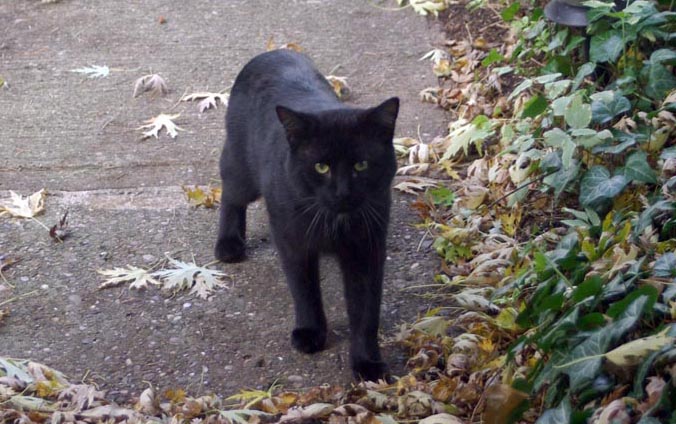
The boys don’t have kittens, but they are still part of the problem
Boys do have babies, they just don’t give birth to them. But that doesn’t leave them off the hook for issues of animal overpopulation, not to mention the nasty behaviors unneutered cats indulge in. I had a friend who thought she lived too far from anyone else and decided not to neuter her male kitten, but not to worry, the girls found him! Read about that and why, just as we spay our girls we also need to neuter our boys and encourage others to do so as well.
Chances of feline breast and reproductive cancer, reduced to nearly nothing
Feline breast cancer is the third most common cancer among cats after lymphoma and skin cancer. In a 2005 study done at the University of Pennsylvania, “cats spayed prior to 6 months had a 91% reduction…those spayed prior to one year had an 86% reduction in the risk of mammary carcinoma development compared with intact cats.” Spaying between 1 and 2 years of age only reduces the risk by 11%, and after two years it doesn’t reduce the risk at all. Actually giving birth to kittens doesn’t change the risk factors, either. Read more about feline breast cancer.
Yes, it is expensive, but affordable alternatives are available
Please check my Shelters, Assistance, Spay/Neuter page for opportunities in Pittsburgh and beyond.
Find a low-cost clinic anywhere in the country
If you or a friend or family member find a spay for your cat to be more than you can afford, check this link to search for a low-cost spay or neuter by zip code all over the country sponsored by the Humane Society of the United States, PetSmart Charities and the ASPCA. If you’re not near Pittsburgh and you’d like to find out if there is a TNR organization near you, visit the Feral Cat Organizations listing on the Humane Society of the United States’ website. You can also find information on the Alley Cat Allies’ website under Make Connections. You can find yet more resources on the ASPCA website under TNR and Colony Management.
You don’t need to manage a colony to help feral cats. You can donate to, assist or even start a local TNR program in your area. The HSUS’s article What You Can Do to Help Feral Cats covers finding local organizations, listing options and how to pursue helping or starting a local organization, and they also have a Program Fund that you can donate to in order to assist them in helping local organizations form and operate.
Read more articles about the need to spay and neuter our cats
I have heard since I was a child, in so many ways, that cats were disposable because there were always “more where those came from”. This broke my heart as a child, and still does today. I am convinced that this flippant ideal of disposability through overpopulation fuels disrespect of cats and devalues each cat, even underlies the fact that otherwise loving cat owners take their cat to the vet half as often as dogs visit the vet. Reducing the unwanted cat population elevates every cat.
I have a lot to say on this subject, in part because the flip side of it is a lot of cat rescue and a lot of unhappy endings because of all the unwanted kittens born all the time. Sometimes it honestly feels like there are 420,000 unwanted kittens born every day, but just several hundred is too many. Click here for an archive of articles on spay/neuter, fostering, assisting shelters and doing all you can to help reduce the population of homeless cats and kittens.
Gifts featuring cats you know! Visit Portraits of Animals
Fine Art • Photography • Gifts • Greeting Cards • Books • Commissioned Portraits & Artwork
Great Rescues Day Book:
Portraits, Rescue Stories, Holidays and Events, Essential Feline Information, All in One Book
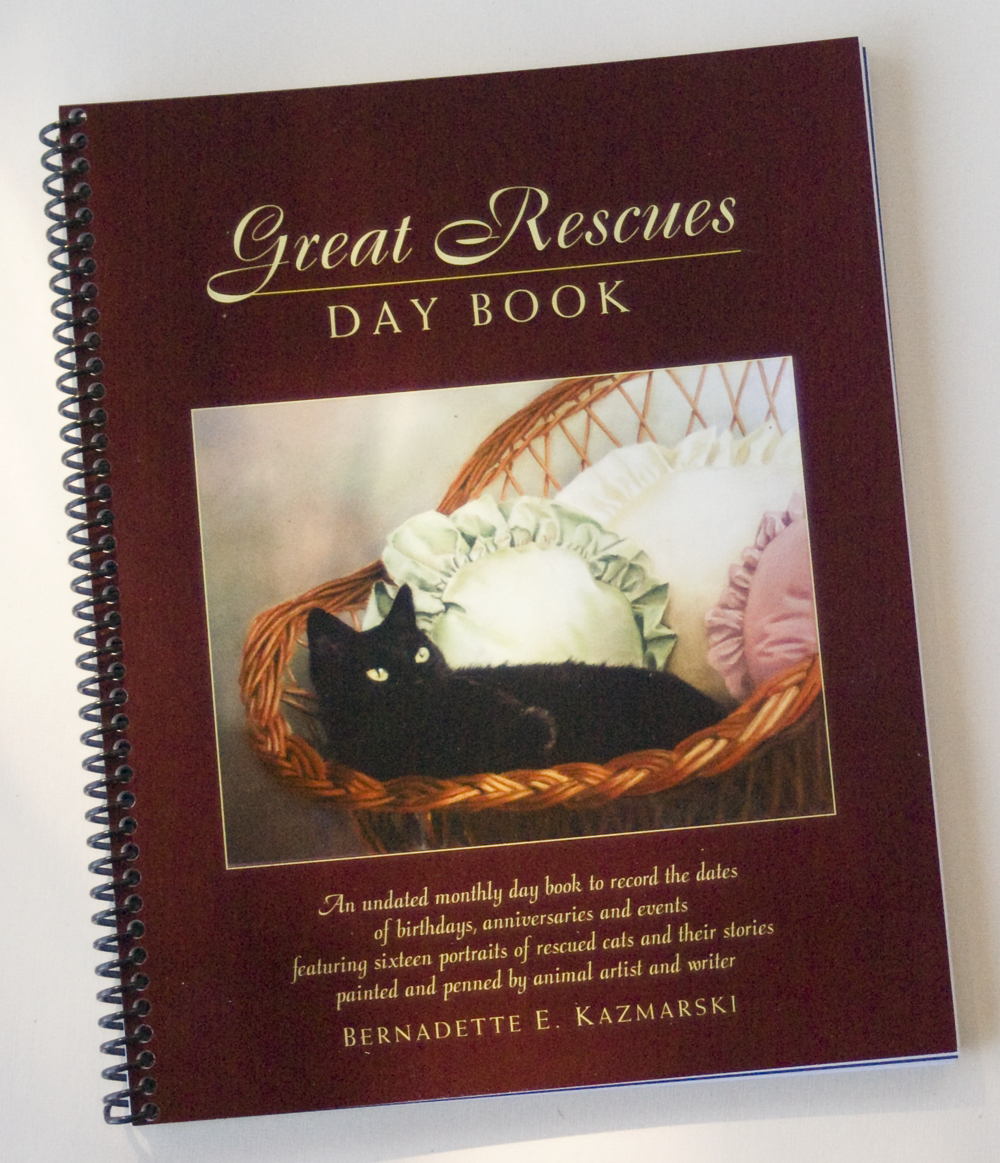
Each month features one of my commissioned portraits of a feline or felines and their rescue story along with a kitty quote on the left page, and on the right page the month name with enough lines for all possible dates, with standard holidays and animal-themed observances and events. Great Rescues also includes a mini cat-care book illustrated with my drawings including information on finding strays or orphaned kittens, adopting for the first time or caring for a geriatric cat, a list of household toxins and toxic plants, or helping stray and feral cats and beginning with TNR.
Each book includes also 10 sheets of my “22 Cats” decorative notepaper with a collage of all the portraits in black and white so you can make your own notes or write special notes to friends.
The portraits in this book, collected as a series, won both a Certificate of Excellence and a Muse Medallion in the 2011 Cat Writers’ Association Annual Communication Contest, as well as the 22 Cats Notepaper mentioned below.

Copyright
All images and text used on this site are copyrighted to Bernadette E. Kazmarski unless otherwise noted and may not be used without my written permission, although links to your site are more than welcome and are shared. Please ask if you are interested in using and image or story in a print or internet publication. If you are interested in purchasing a print of an image or a product including it, check my animal and nature website Portraits of Animals to see if I have it available already. If you don’t find it there, visit Ordering Custom Artwork for more information on a custom greeting card, print or other item.
Subscribe to my e-newsletter
Subscribe to The Creative Cat Preview E-newsletter.
© 2022 | www.TheCreativeCat.net | Published by Bernadette E. Kazmarski
Weekly schedule of features:
Sunday: Essays, Pet Loss, Poetry, The Artist’s Life
Monday: Adoptable Cats, TNR & Shelters
Tuesday: Rescue Stories
Wednesday: Commissioned Portrait or Featured Artwork
Thursday: New Merchandise
Friday: Book Review, Health and Welfare, Advocacy
Saturday: Your Backyard Wildlife Habitat, Living Green With Pets, Creating With Cats
And sometimes, I just throw my hands in the air and have fun!
PORTRAITS OF ANIMALS WEBSITE
FACEBOOK | TWITTER | LINKEDIN | PINTEREST | TUMBLR | INSTAGRAM | YOUTUBE| EMAIL | PATREON



We can sure relate to that since we’ve done over 700 (we quit counting at 735) though the years. Bless you for helping so many! We’ve got some new additions to our feral family so we’ll be dusting off the traps soon.
And thank you for all your work too! I think we’ve both had large households of our rescues. Not only did I not realize I would be in this house for 30+ years, I also had no idea how many cats I would “handle” in those years, most of them in my own neighborhood. I didn’t really keep count until I started blogging and writing about them. I always hope to be a good example for others who need to find their own niche in rescuing and helping cats and animals, and from there to encourage people to jump in and help.